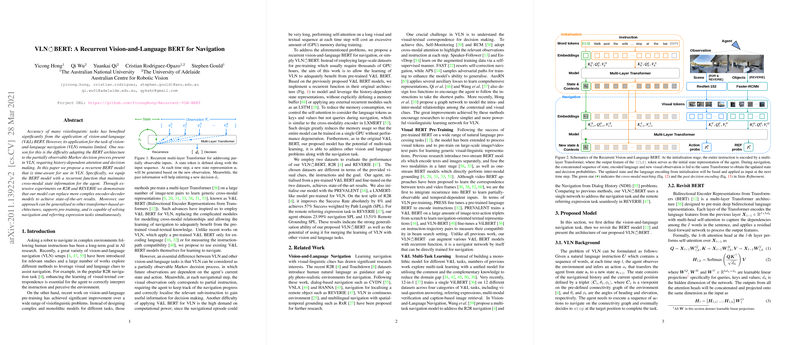Insights into the Paper: "VLN$: A Recurrent Vision-and-Language BERT for Navigation"</h2>
<p>The paper "VLN$: A Recurrent Vision-and-Language BERT for Navigation" proposes an innovative model that blends vision-and-language navigation (VLN) with the transformative capabilities of BERT architectures. VLN presents unique challenges as it operates under a partially observable Markov decision process, where agents must interpret complex environments based on visual and language inputs to make autonomous navigation decisions. Traditional BERT architectures, while potent in visiolinguistic tasks, struggle with VLN's demands due to their static nature and high computational requirements when applied idly to dynamic navigation tasks.
Model Proposition: Recurrent BERT for VLN
The authors introduce a recurrent function into the BERT model to address the temporal dependencies intrinsic to VLN tasks. This approach subsumes the dynamic nature of the navigational process by maintaining cross-modal state information across time steps. The model leverages pre-trained Vision-and-Language (VL) BERT to develop a time-aware architecture capable of handling the sequential decision-making process required in VLN.
Key Components:
- Recurrent State Maintenance: The model effectively updates the agent's state through a recurrent mechanism without the explicit need for traditional memory structures found in models like LSTM.
- Memory Efficiency: By redesigning attention mechanisms, particularly in handling textual features only at initialisation, the model drastically reduces memory consumption, making it feasible to train on a single GPU.
- Unified Task Learning: The framework supports multitasking capabilities across navigation and referring expression tasks, showcasing its robustness and flexibility.
Numerical Evaluation and Performance
The model demonstrates superior performance on widely used datasets such as R2R and REVERIE, achieving state-of-the-art results. Notably, the model enhances the Success Rate weighted by Path Length (SPL) on the R2R test split by 8% and shows similar improvements on REVERIE tasks. Additionally, through robust pre-training and efficient design, the model significantly reduces computational time compared to other methods, achieving these results within notably fewer training iterations.
Implications and Future Prospects
The implications of this research extend beyond mere performance enhancement in VLN tasks. The capability of adapting pre-trained VL BERT models with recurrent functions paves the way for their application in broader AI domains requiring sequential decision-making. Given the results demonstrated, future work could explore expanding this approach to other intensive interaction-based tasks like visual dialog, dialog-based navigation, and real-time robotic response systems.
Furthermore, the fusion of pre-trained visiolinguistic knowledge and computational efficiency highlights the model's potential as a benchmark approach for combining linguistic and visual information in AI tasks with sequential decision-making needs. This research contributes valuable insights into the design and implementation of AI systems capable of operating under dynamically complex conditions while maintaining manageable computational costs. As such, the foundational work established herein invites future explorations into refining and extending recurrent architectures for a broader class of real-world interaction problems in AI.
